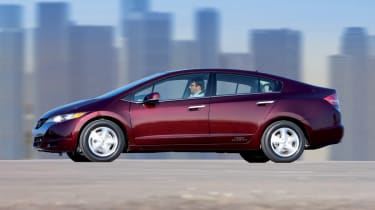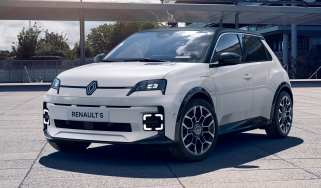Honda FCX Clarity
We're the first to drive Honda's hydrogen-powered FCX
The Japanese company leads the world into a fuel cell future – but is the rest of the planet following? The FCX Clarity is a stunning debut for this new technology, and it drives brilliantly for a first-generation machine. Yet huge questions remain about the sustainability and practicality of a hydrogen-fuelled destiny. With a cost of £300 per month to lease the car, Honda won’t be making much money on it, either. Nevertheless, as a demonstration of technological prowess, no other vehicle comes close.
It’s got a top speed of 100mph, will sprint from 0-60mph in 10 seconds and costs £300 a month to rent. And it doesn’t use a drop of petrol.
Powered by hydrogen, the long-awaited Honda FCX Clarity doesn’t only represent the future, but the beginning, too. That’s because this is the first commercially available fuel cell vehicle in the world.
Launched at the Los Angeles Motor Show earlier this month, the FCX Clarity had queues of wealthy, in-the-know celebrities and ordinary folk itching to drive it... but Auto Express managed to elbow its way right to the front in order to get a ride in the car first.
So, with customer deliveries due to begin in the US next summer, what can the initial owners expect of a machine that could lay claim to be the Ford Model T of its era?
Just one look will be enough to convince you that the Honda is more than up to the task of setting new standards. A concept version of the car debuted at the Paris Motor Show in 2006, but the FCX Clarity’s sweeping body lines have been slightly modified for production. The shell is now made from pressed steel rather than carbon fibre, which not only helps to reduce the cost, but cuts the transmission of noise from the fuel cell, too.
Rules of the road also mean additional crash protection at the front, along with new bumpers. The windscreen pillars have been relocated to reduce wind, road and engine noise, while at the rear the luggage compartment has grown to improve the car’s aerodynamic shape. As with its Insight stablemate, the FCX gets a ‘porthole’ window running under the bootlid to improve rearward visibility.
Inside, the changes from the concept are immediately apparent. There is a better-built facia and dashboard, plus production-level quality and finish and a nicer feel to the corn-based bio-fabric used to trim the seats and doors. Apparently this is edible, but we didn’t have a nibble.
As soon as you turn the ignition key, you can hear the fuel cell is much quieter than the concept car which inspired it. While that model emitted an irritating whine, the production machine makes more of a soft, jet engine-like murmur. There have also been changes to the hydrogen storage capacity and the electric motor, and the overall weight has been cut to 1,625kg from the concept’s 1,680kg.
On top of the impressive performance, this helps to provide the FCX with a range of 270 miles, as well as claimed energy-equivalent fuel consumption of around 81mpg.
While it’s no sports car, the Honda certainly moves. Initial acceleration is disarmingly fast and the car gains speed up to and beyond 50mph. The ride is hard, partly because of the stiff anti-roll bars, and on rippled roads it bounces along. However, on smoother surfaces it’s much more comfortable, and the FCX corners well, too.
Yes, the average German saloon would out-handle the emissions-free Honda, but that is missing the point. With oil at nearly $110 a barrel and US petrol prices higher than ever – although still only the equivalent of £1.86 per imperial gallon – green is cool in California, and the FCX Clarity fits perfectly into that groove.
In the future, Honda wants to bring this car, or something very much like it, to our showrooms with a price tag of around £50,000. For some, that can’t come soon enough.
Rival: VW Space UP! Blue
Honda’s reinvention of the family car features radical technology but familiar looks. In contrast, the fuel cell VW up! is radical both in its hydrogen engine and its design – fully exploiting the advantages offered by its compact powertrain.



